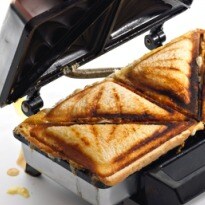From Michelin-starred chefs to street-food stalls, everyone is making toasted sandwiches. Is it a flash in the pan or the welcome return of a true cheesy treat?
No food ever truly disappears. Foods are mistreated and become unfashionable, but there is always someone, somewhere serving melon with Parma ham, duck a l'orange, fruit salad - and there are always people happy to pay for it. So, let's not say that the toastie is back, but that this neglected classic is definitely enjoying something of a moment.
Within the rarefied splendour of Berners Tavern in London, Jason Atherton has been serving a dose of 1970s nostalgia: a black pudding Breville toastie, albeit made with brioche. Elsewhere in the capital, Loaf now serves a dedicated toastie menu, as will Poppy's Place when it opens in Fulham next month.
Meanwhile, from hip East End wine bar Sager + Wilde to Manchester's Volta, Liverpool's Baltic Bakehouse to Bristol's superb Pickle food truck, there are suddenly examples of America's favourite toastie - AKA the grilled cheese sandwich - everywhere. Little wonder that Restaurant magazine picked the once humble toastie as one of its main trends for 2014.
That's a fashionable fad we can all get behind, right? It is hot, melting cheese in a crisp, buttery pocket and, depending on where you eat, everything from hot salt beef to pulled pork stuffed in there, too. Plus, after years of neglect, these new wavers are, finally, giving the toastie the respect it deserves.
Despite what you may find up and down Britain, a toastie is not simply a sandwich made with toasted bread, nor is it a dry, crusty panini filled with any old rubbish and shoved into a sandwich press to warm it through for a minute. Whether made in a Breville, a press or a frying pan; whether you butter the outside of the bread or the appliance itself, a genuine toastie needs an outer coating of fat to which there must be a direct application of heat, so that its exterior develops a magical golden crust.
As Nisha Patel, one half of London street food outfit Grill My Cheese (GMC), puts it: "Most people would think that it's difficult to get wrong, but factors such as cheese to bread ratios, poor-quality ingredients and grilling methods can all produce sub-par toasties. For us, having a product that is essentially a simple idea meant it had to be perfect."
Many Americans swear by spreading mayo on the outside of the sandwich (or even vegetable oil and yoghurt), but GMC uses unsalted butter: "This provides the buttery flavor and a crisp crust without being greasy." On the stall, Patel and Nishma Chauhan use an industrial griddle and a cast-iron press on top of their sandwiches to replicate their preferred frying pan method for a mass audience. For a "gourmet" take on this usually highly processed US diner classic, they use a blend of artisan cheeses, fresh sauces and homemade fillings on organic sourdough bread.
Gastronomic snobs and class warriors alike might scoff at all this: another crass, calorific US import being given a foodie makeover. But the beauty of the toastie is that it is a genuine treat, easily made at home, which, if you spend a quid or two more on ingredients, you can transform into a moment of intense pleasure. Insomuch as affordable luxury exists, this is it. Comfort food in excelsis.
Not that the toastie (third-degree burns from molten bean and cheese fillings; the whole concept of the tuna melt), doesn't have its issues, which this root and branch rethink of what the toastie is and can be should address. But do tarted-up toasties whet your appetite? Is it time, once more, to revel in the Breville?
Photo: The Breville sandwich toaster produces that magical golden crust. Photograph: Alamy












